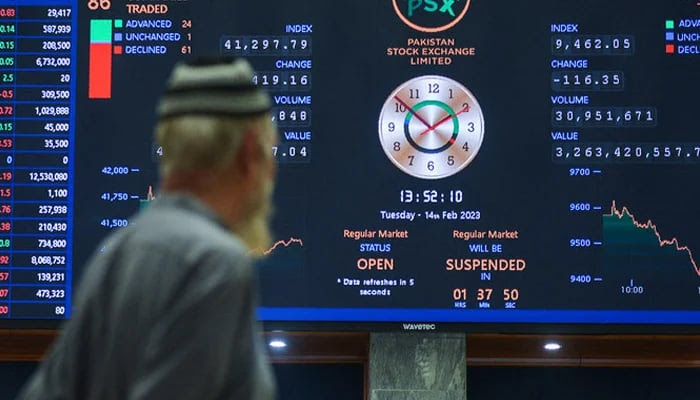July 21, 2023 (MLN): Imagine a life without access to a bank account, a credit card, a loan, or any other financial service. In such circumstances, handling such basic tasks like savings, bill payments, or dealing with emergencies becomes immensely challenging.
Unfortunately, this is the reality for approximately 1.4 billion adults worldwide who are considered "unbanked" due to their lack of formal connections with financial institutions.
Among these individuals, a significant 9% reside in Pakistan, a country struggling with a substantial financial exclusion, as a report by A. F. Ferguson & Co., a member of PWC highlighted.
Nevertheless, this also presents an opportunity for Pakistan to create a positive impact on the lives of countless individuals by enhancing accessibility to cost-effective and dependable financial services.
Compared to certain regional peers and emerging economies such as Bangladesh, Sri Lanka, Kenya, and India where financial inclusion is well above 50%, Pakistan’s positioning reflects enormous space.

Sources: PwC proprietary insights and analysis, World Bank
Hurdles
According to Global Findex Database 2021, the underlying reasons for low financial inclusion in Pakistan for not opening bank accounts range from lack of documentation, lower trust, religious factors, physical proximity of branches, to affordability of financial solutions and insufficient funds.
Global Findex Database 2021 (% of respondents, age 15+)

Sources: PwC proprietary insights and analysis, World Bank
Lack of CNIC, mobile phone access, and basic numeracy skills are key hurdles commonly cited for low inclusion. Whilst these apply to both genders, the widest disparity may exist for financial literacy and mobile SIM ownership, the report noted.
Generally, people who are unbanked are also those who are the hardest to reach and may mainly include those residing in rural areas. Financial inclusion in rural Pakistan stands at 15%, and in terms of value is 16% of the total deposit balance held by individual customers as of June 2022.
Developments
Over the last 3 years, some banks have introduced women-centric propositions, with females at these institutions now comprising 20%-25% of the customer base, with an active account ratio between 60%-70%.
Some banks are actively working on broadening access to financial services through a physical footprint complemented by digital propositions. They have managed to optimize rural accounts in the range of 25% to 35% of the total individual customer base.
The number of accounts held by individuals rose by 49%, i.e. from 40 million in 2017 to 60m as of June 2022. Of these, there are 8 million accounts with a balance of less than Rs5,000 comprising 14% of the total base for individuals. However, in 2017, there were only 1.7m such accounts, representing 4% of the aggregate, the document added.
Similar trends are noted for business accounts where low-value accounts comprise 19% of the total number of business accounts, up from 8% in 2017.
Cash in circulation stands at Rs7.69 trillion, a huge 96% increase from Rs3.93tr in 2017, approximating 1/3rd of total deposits held at banks.
SBP has undertaken several initiatives over the past two decades to enable inclusive economic growth, notable ones include:
- Fostering a diversity of financial institutions through separate licensing regimes for microfinance banks, digital banks, and Electronic Money Institutions (EMIs)
- Facilitating account opening through mobile wallets
- Expansion and modernization of online credit information bureau (e-CIB)
- Interoperable inter-bank card payments platforms
- A tiered approach to KYC, with Branchless Banking (including Asaan Mobile Account), enabled via mobile wallets and USSD
- Limited KYC account schemes such as Asaan Account, Asaan Digital Remittance Account, Freelancer Digital Account etc.
- RAAST – instant payment system
- Digital on-boarding of merchants
- Nationwide Financial Literacy Programme
- Child and Youth Financial Literacy Programme
Branchless Banking in Pakistan, introduced in 2008 with the primary objective of financial inclusion and option for remote on-boarding, today there are 16 Branchless Banking players with 97 million wallets, holding the aggregate balance of Rs88 billion
Over the last 5 years, the balance per wallet has slowly increased from Rs565 to Rs900. The active account ratio over the same period, however, has declined from 52% to 44%.
The Branchless Banking proposition pivoted two key use cases for digital banking. The first is customer acquisition with limited KYC, and the second is fund transfers through mobile.
Around 1/3rd of the 16 Branchless Banking players are more active in this space. Of those, few have rebranded their platforms aiming to provide a digital experience to the tech-savvy youth, with the objective to shift those customers from branchless to mainstream banking.
Mr. Muhammad Aurangzeb, President & CEO, HBL stated, “We all must remain committed to financial inclusion. I believe that everyone, regardless of their background, should have access to financial services.”
“That is why the industry should be investing in digital banking and other initiatives to make it easier for people to bank. Data-driven insights enable banks to provide more contextualized products to the right audience and extended relevant banking services to previously unbanked communities,” he added.
The report highlighted some potential solutions to narrow this gap, which include ongoing measures by the Government and regulators around limited KYC account schemes, broadening access to financial services, and financial literacy.
Financial inclusion may remain a persistent challenge, particularly due to inherent country dynamics and the recent inflationary wave, creating further financial burdens and reducing the already low propensity to save.
At the same time, it also presents an opportunity for Pakistan to create a positive impact on the lives of countless individuals by enhancing accessibility to cost-effective and dependable financial services.
Copyright Mettis Link News
Posted on: 2023-07-21T12:15:29+05:00







